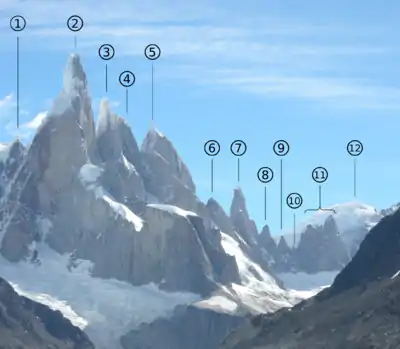Torre Egger
Torre Egger is one of the mountains of the Southern Patagonian Ice Field in South America. It is located in a region which is disputed between Argentina and Chile,[2] west of Cerro Chalten (also known as Fitz Roy). The peak is between Cerro Torre, the highest in a four mountain chain[3] and Cerro Stanhardt. It is named after the Austrian alpinist Toni Egger (1926-1959), who died while attempting neighboring Cerro Torre.

| Torre Egger | |
|---|---|
| Highest point | |
| Elevation | 2,685 m (8,809 ft) |
| Prominence | 275 m (902 ft) [1] |
| Coordinates | 49°17′34″S 73°05′54″W |
| Geography | |
| Location | Patagonia, Argentina, Chile (disputed)[2] |
| Parent range | Andes |
| Climbing | |
| First ascent | February 1976: Bragg, Donini, Wilson (US) |
| Easiest route | rock/snow/ice |
First ascent
In 1976, John Bragg, Jim Donini and Jay Wilson from the United States climbed Torre Egger by climbing first to the col between the peak and Cerro Torre, the Col of Conquest, and then up the ridge to the peak. The ascent was hampered by bad weather and took from December 1975 to February 22, 1976 when the 3-person team summitted.[4]
Other ascents
- 1986 Psycho Vertical (Southeast Face) (UIAA ED+ VII+ A3 90deg, 950m) Janez Jeglic, Silvo Karo, Franc Knez (Yugoslavia), December 7, 1986.[5]
- 1987 Titanic (East Pillar) (UIAA VI+ A2), Maurizio Giarolli and Elio Orlandi (Italy), November 2 to 5, 1987.[6]
- 1994 Badlands (YDS VI 5.10 A3 WI4+, 1000m) Conrad Anker, Jay Smith and Steve Gerberding (US), FA 12 December 1994.[7]
- 2005 Titanic (East Pillar) (UIAA VI+ A2) Steph Davis, Dean Potter. The first female ascent of Torre Egger and likely the first one-day ascent of the mountain.[8][9][10]
- 2012 Die another day" (west face) (UIAA VIII A1) Matteo Bernasconi, Matteo Della Bordella . The route end up 25m below col de lux.
- 2013 Notti magiche" (West face) (UIAA VIII A1) Matteo Della Bordella, Luca Schiera. From Col de Lux to the top the Italian duo has followed the Huber-Sharf, 200m of rock and then ice line[11]
In January 2008, Rolando Garibotti and Colin Haley made the first complete traverse of the entire massif, climbing Aguja Standhardt, Punta Herron, Torre Egger and Cerro Torre together. They rate their route at Grade VI 5.11 A1 WI6 Mushroom Ice 6, with 2,200 m (7,200 ft) total vertical gain. This had been "one of the world's most iconic, unclimbed lines", first attempted by Ermanno Salvaterra.[12]
References
- "Torre Egger, Argentina". Peakbagger.com. Retrieved 2014-06-10. Note: The prominence value given here was calculated from the difference between an elevation of 2850m for Torre Egger and 2575m for Col de la Conquista, the key col for Torre Egger.
- From Rodrigo Jordan, "Cerro Torre", in World Mountaineering, Audrey Salkeld, editor, Bulfinch Press, ISBN 0-8212-2502-2, p. 156: Cerro Torre rises "on the border between Chile and Argentina." However Chile and Argentina have long-standing border disputes.
- Torre Egger 2005, Huberbuam Archived 2009-05-11 at the Wayback Machine
- Bragg, John (1977). "Torre Egger". American Alpine Journal. New York: American Alpine Club. 21 (51): 49–56. ISBN 978-0-930410-31-5.
- Karo, Silvo (1988). "Torre Egger's Southeast Face". American Alpine Journal. New York: American Alpine Club. 30 (62): 49–51. ISBN 978-0-930410-33-9.
- Orlandi, Elio (1988). "The Eastern Pillar of Torre Egger". American Alpine Journal. New York: American Alpine Club. 30 (62): 52–55. ISBN 978-0-930410-33-9.
- "Cerro y Agujas del Cordon Torre". Climbing in Patagonia. Archived from the original on 2009-06-20. Retrieved 2009-05-27.
- http://www.climbing.com/news/wild-times-in-patagonia/
- https://www.theguardian.com/sport/2007/may/06/features.sport9
- http://www.alpinist.com/doc/ALP11/climbing-note-davis-2/
- "Archived copy". Archived from the original on 2013-12-12. Retrieved 2013-12-12.CS1 maint: archived copy as title (link)
- Garibotti, Rolando (September 2008). "The Torre Traverse". Alpinist. Jackson, Wyoming: Alpinist Magazine. 2008 (25): 52–59.